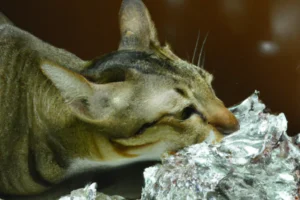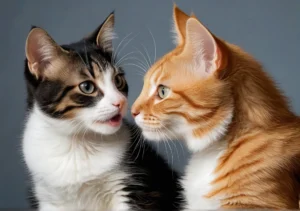Cats can be finicky creatures, often displaying peculiar behaviors that leave their owners scratching their heads. One common sight that many cat owners have witnessed is their feline friend jumping away in alarm at the sight of a seemingly harmless object: aluminum foil. But why do cats react this way to aluminum foil?
It seems that the crinkly texture and shiny surface of aluminum foil can trigger a cat’s natural instincts and senses, causing them to feel threatened or startled. The unexpected sound and feel of the foil under their paws can mimic the sound of hissing or spitting, which are warning signs in the feline world. This, coupled with the reflective nature of the foil, can create a confusing and intimidating experience for your cat, prompting them to leap away in a defensive response.
Sensory Sensitivity
Cats have heightened senses compared to humans, which can contribute to their reaction to aluminum foil. The crinkly sound of foil, combined with its shiny surface, can be overwhelming to their sensitive hearing and sight. This sensory overload can trigger a fear or avoidance response in cats, causing them to jump away or exhibit anxious behavior around aluminum foil. Additionally, the texture of foil may feel uncomfortable on their paws, further adding to their aversion.
Instinctual Behavior
When it comes to cats jumping away from aluminum foil, it’s not just about their senses – it’s also about their instinctual behaviors. Cats are natural hunters and predators, always on alert for potential threats in their environment. Anything new, shiny, or noisy can trigger their flight response, as they instinctively perceive it as a potential danger. This instinct to avoid the unknown or potentially harmful objects is deeply ingrained in their behavior, leading them to react fearfully to unfamiliar stimuli like aluminum foil.
Unique Insight: One fascinating aspect of a cat’s instinctual behavior is their tendency to view certain objects as potential predators due to the uncertainty they bring. This can explain why they react defensively to items like aluminum foil, which they perceive as a threat to their safety. Understanding this aspect of their behavior can help pet owners create a safe and comfortable environment for their feline companions.
Playful Responses
Have you ever noticed your cat doing acrobatics when encountering aluminum foil? Some felines actually find the crinkly texture of aluminum foil super intriguing. It triggers their playful instincts, making them jump, pounce, and bat at the foil as if it were a fun toy. So next time you see your cat leaping around the foil, just remember, they’re not scared, they’re just having a blast!
Training Techniques
If your cat is scared of aluminum foil and reacts by running away, there are effective training techniques you can use to help them overcome their fear. One method is gradual desensitization – start by introducing small pieces of foil in areas your cat frequents, rewarding them for calm behavior. Slowly increase exposure until your cat learns that foil is harmless. Positive reinforcement, like treats and praise, can also help change your cat’s association with aluminum foil from fear to indifference.
Here are a few more tips to help your furry friend get used to aluminum foil: 1. Start Small: Begin by placing small pieces of foil in areas where your cat plays or eats. 2. Be Patient: Training takes time, so don’t rush the process. 3. Reward Good Behavior: Encourage your cat with treats or affection when they remain calm around the foil. 4. Consistency is Key: Stay consistent with your training techniques to help your cat adjust more quickly.
By using these training methods, you can help your cat feel more comfortable around aluminum foil and reduce their instinct to jump away from it.
Alternative Deterrents
If your furry friend is the mayor of Jumpsville whenever aluminum foil comes around, fear not! There are other cat-approved alternatives to keep them away from unwanted areas. Citrus-scented sprays work wonders as cats typically detest the smell. Double-sided tape is also a clever trick as most felines dislike the sticky sensation on their paws. Another option is motion-activated deterrents, which emit a harmless burst of air or noise when your cat gets too close. These alternatives offer a cat-friendly solution without the crinkle of aluminum foil.
Feline Enrichment
Your kitty’s acrobatics around aluminum foil could be a sign of boredom or anxiety. Providing enrichment and mental stimulation is key to preventing these behaviors. Invest in interactive toys like puzzle feeders or laser pointers to keep your cat entertained. Create vertical spaces with cat trees or shelves for them to climb and explore. Hide treats around the house for a fun scavenger hunt. Engaging your cat’s mind and body with enriching activities will help curb their urge to leap away from aluminum foil in search of excitement.
For more enrichment ideas and how to create a stimulating environment for your feline friend, check out this helpful resource from the American Association of Feline Practitioners: Feline Enrichment
DIY Cat Toys
When trying to engage your cat’s natural instincts and provide a safe outlet for their energy, consider making DIY cat toys. Cats have an innate curiosity that can be piqued by simple homemade toys. Try creating toys using materials like cardboard, feathers, or even crumpled paper. By giving your cat interactive playthings, you can help keep them mentally stimulated and physically active.
To add an extra element of fun, incorporate catnip into some of the toys you make. Catnip is a herb that drives many cats wild, and including it in a toy can enhance your cat’s playtime experience. Additionally, rotating the toys regularly can prevent your cat from getting bored and losing interest in them over time.
Remember, safety should always come first when creating DIY toys for your cat. Avoid using small parts that could be swallowed and ensure that any materials you use are non-toxic. By taking the time to craft engaging toys for your feline friend, you can foster a deeper bond and provide them with hours of entertainment.
Cat Behavior Consultation
If your cat’s fearful reactions to aluminum foil persist or escalate, it may be beneficial to seek professional guidance from a certified cat behavior consultant. These experts specialize in understanding feline behavior and can provide valuable insights into why your cat may be exhibiting certain behaviors.
A behavior consultant can work with you to develop a customized plan to help address your cat’s specific needs and fears. Through observation and analysis, they can pinpoint the underlying reasons for your cat’s reactions to aluminum foil and recommend strategies to help your cat feel more comfortable and secure.
By consulting a professional, you can gain a better understanding of your cat’s behavior and learn how to effectively manage their fear or anxiety. Don’t hesitate to reach out for help if your cat’s reactions are causing distress for you or your pet.
Tip : When looking for a cat behavior consultant, make sure to choose a certified professional with experience in working with fearful or anxious cats.
Incorporating these insights into your understanding of why cats jump away from aluminum foil can help you navigate your feline friend’s behavior with greater empathy and insight. Next time you reach for that roll of aluminum foil, you’ll have a better understanding of why your cat may react the way they do.
Alex, a passionate animal lover, has experience in training and understanding animal behavior. As a proud pet parent to two dogs and three cats, he founded AnimalReport.net to share insights from animal experts and expand his knowledge of the animal kingdom.




